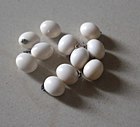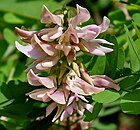Note: This is a project under development. The articles on this wiki are just being initiated and broadly incomplete. You can Help creating new pages.
Difference between revisions of "Achyranthes aspera - Apamarga, Devil's horsewhip"
(→Chemical Composition) |
(→Chemical Composition) |
||
| Line 11: | Line 11: | ||
==Chemical Composition== | ==Chemical Composition== | ||
| − | Roots contains: triterpenoid saponins, betaine, achyranthine, hentriacontane, ecdysterone and two glycosides of oleanolic acid. Seeds: amino acids.<ref name=" | + | Roots contains: triterpenoid saponins, betaine, achyranthine, hentriacontane, ecdysterone and two glycosides of oleanolic acid. Seeds: amino acids.<ref name="Chemical Composition"/> |
==Common names== | ==Common names== | ||
Revision as of 16:37, 6 April 2018
Achyranthes aspera is a species of plant in the Amaranthaceae family. It is distributed throughout the tropical world. It can be found in many places growing as an introduced species and a common weed. It is an invasive species in some areas, including many Pacific Islands environments.
Contents
Uses
body aches, Post-abortion pain, Costodynia, jaundice, Post- partal fever, Anorexia, Amenorrhoea, Dysmenorrhoea, Menoxenia, Leucorrhoea, Habitual abortion.
Parts Used
Chemical Composition
Roots contains: triterpenoid saponins, betaine, achyranthine, hentriacontane, ecdysterone and two glycosides of oleanolic acid. Seeds: amino acids.[1]
Common names
| Language | Common name |
|---|---|
| Kannada | Uttaranee |
| Hindi | Chirchita, Latjira |
| Malayalam | Kadaladi, Katalati |
| Tamil | Nayurivi, Shiru-kadaladi |
| Telugu | Antisha, Apamargamu, Uttareni |
| Marathi | NA |
| Gujarathi | NA |
| Punjabi | NA |
| Kashmiri | NA |
| Sanskrit | Apamarga |
| English | Prickly Chaff Flower, Chaff-flower, Crocus stuff |
Habit
A wild, perennial, erect herb)
Identification
Leaf
| Kind | Shape | Feature |
|---|---|---|
| simple | Elliptic-obovate | Leaf Apex is Obtuse-acute, Leaf Base is Cuneate and Leaf Margin is Entire. |
Flower
| Type | Size | Color and composition | Stamen | More information |
|---|---|---|---|---|
| Unisexual | 2-4cm long | yellowish-white | Flowering throughout the year and In terminal or axillary spikes |
Fruit
| Type | Size | Mass | Appearance | Seeds | More information |
|---|---|---|---|---|---|
| urticle | falling off with bracteoles and perianths | seed solitary | Fruiting throughout the year | {{{6}}} |
Other features
List of Ayurvedic medicine in which the herb is used
- Vishatinduka Taila as root juice extract
Where to get the saplings
Mode of Propagation
How to plant/cultivate
Cultivated as a food crop in China. A very variable specie.
Commonly seen growing in areas
Photo Gallery
References
- ↑ Cite error: Invalid
<ref>tag; no text was provided for refs namedChemical Composition - ↑ "morphology"
Cite error: <ref> tag with name "chemical composition" defined in <references> is not used in prior text.
External Links
- Pages with reference errors
- Ayurvedic Herbs known to be helpful to treat body aches
- Ayurvedic Herbs known to be helpful to treat Post-abortion pain
- Ayurvedic Herbs known to be helpful to treat Costodynia
- Ayurvedic Herbs known to be helpful to treat jaundice
- Ayurvedic Herbs known to be helpful to treat Post- partal fever
- Ayurvedic Herbs known to be helpful to treat Anorexia
- Ayurvedic Herbs known to be helpful to treat Amenorrhoea
- Ayurvedic Herbs known to be helpful to treat Dysmenorrhoea
- Ayurvedic Herbs known to be helpful to treat Menoxenia
- Ayurvedic Herbs known to be helpful to treat Leucorrhoea
- Ayurvedic Herbs known to be helpful to treat Habitual abortion
- Herbs with seeds used in medicine
- Herbs with Roots used in medicine
- Herbs with common name in Kannada
- Herbs with common name in Hindi
- Herbs with common name in Malayalam
- Herbs with common name in Tamil
- Herbs with common name in Telugu
- Herbs with common name in Sanskrit
- Herbs with common name in English
- Habit - A wild, perennial, erect herb)
- Index of Plants which can be propagated by Seeds
- Herbs that are commonly seen in the region of tropical
- Herbs





